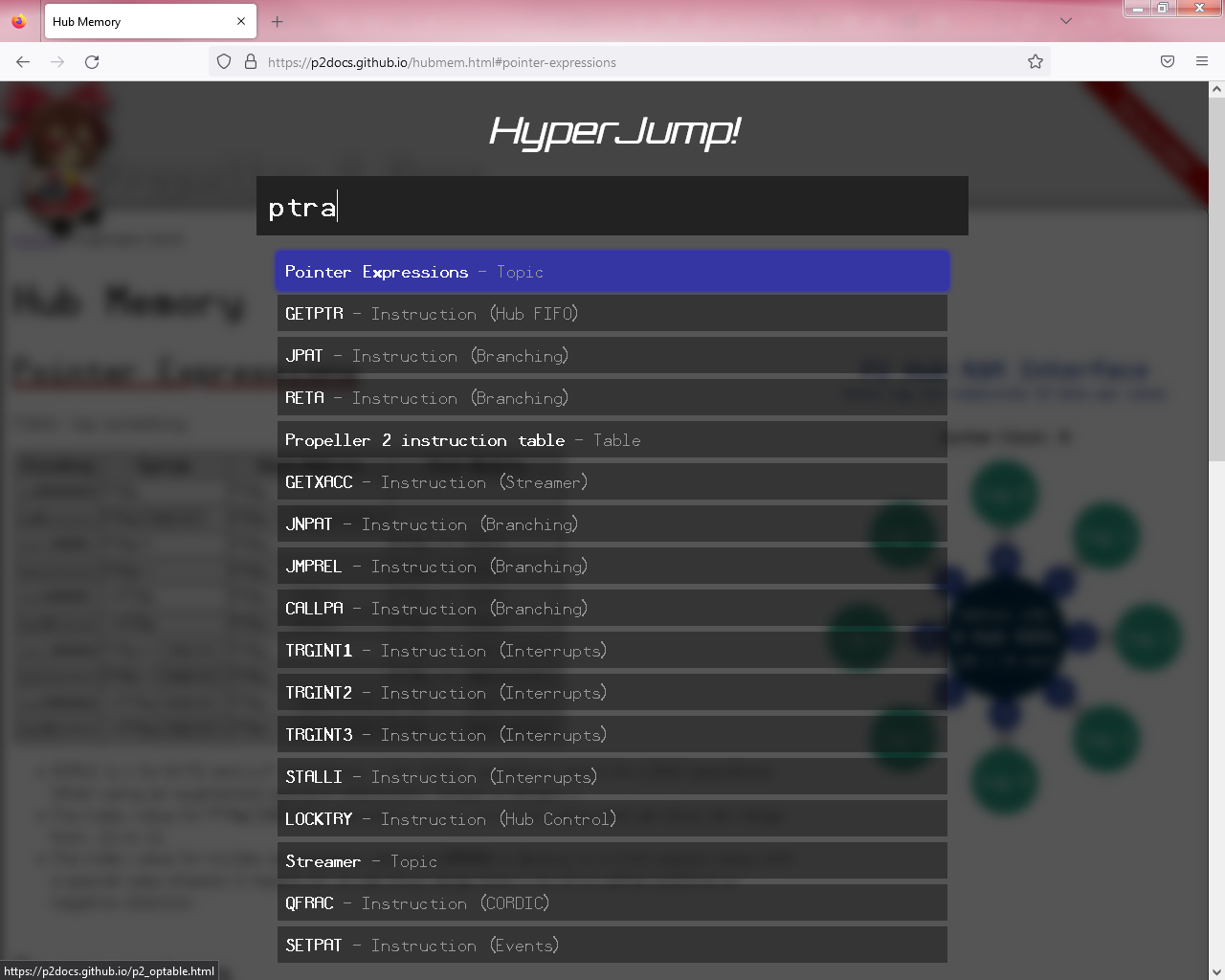New documentation idea
 Wuerfel_21
Posts: 5,745
Wuerfel_21
Posts: 5,745
Been thinking about the sorry state of the P2 docs...
Currently everything is split between multiple slow-loading Google Docs, so it takes a long time to get to where you need to be. Though the same applies to a lesser extent to every documentation format I've seen.
UNTIL NOW.
INTRODUCING HyperJump! TECHNOLOGY! (Pat. pending)
Or in other words: If you use VS Code, you should be familiar with the quick access thing that pops up when you press Ctrl+P. I switch files almost exclusively using this method.
I've never seen it applied to a website / document though. So I quickly proof-of-concepted something up. You can see it here: https://p2docs.github.io . Since a static website doesn't need any text input normally, the the search activates automatically when you start typing, no key combo required. Of course there isn't any actual content in there, just wanted to prototype the idea. All the instruction entries go to 404s. You can try searching for "CORDIC" or "Table" and a few other manually created pages though.



Comments
There are a lot of documentation generators that, while made for code/libraries, can also be applied to hardware pretty easily. I'm a fan of Rust mdBook. Seems that your hyperJump! could be written into a theme for it, making the doc generation much easier. There's also Zeal and Dash which are offline document browsers for Linux/Windows and Mac (respectively). See https://kapeli.com/docsets to build a docset.
Yea, the jumper code is really just one small file that could be loaded into pretty much any website (it even brings its own DOM elements. Just needs to have appropriate CSS loaded) and the data it needs is just a JSON file with
let $hyperJumpList =prepended onto it: https://p2docs.github.io/hjlist.jsOn the other hand, don't underestimate my homebrewn site generator. It has all the markdowns, ERBs and SCSSes you could ever want (though ERB and markdown together creates some friction). ERB templating in particular is really powerful in the sense that you can just suck up data files and work with them (the instruction table is directly read from the CSV that google sheets exports). I also have a plugin that can auto-create small versions of images, but the p2docs site doesn't have it loaded.
Let's assume I know nothing about documentation (not entirely true but..).
This is shockingly fast! I mean it. Really. I've just tried.
The real problem is the actual documentation needs to exist in the first place. If we could only have both corners covered equaly well...
There is always hope, always.
Thanks for that @Wuerfel_21.
Yea, need to get all the instructions together. The instruction sheet is a bit obnoxiously formatted, so I may have to create a new machine-readable instruction description file from almost-scratch.
Well, I created all the pages and instruction headers now (still using data scraped from the spreadsheet). No more 404s.
I also added the all-important images for the bit permutes already.
Oh, forgot to mention, there's an issue currently wherein the multiple JMP/CALL opcodes aren't shown. Also, IDK what's going on with AKPIN.
I should probably set it up such that it can also merge multiple similar instructions (SETSEx etc).
I also should probably make the H3s a bit bigger.
Just tried it, nice and fast. Once complete it will be handy for instruction lookup reference material. I like how pressing space can bring up a list of other topics.
That's not even an intentional feature. It's just that most of the "Topic" entries have a space in their name. Most of them just link to the top of one of the instruction pages - The intent is to have the general explanation of the streamer/cordic/etc there and the individual instructions below.
EDIT: (Relatedly, I think the web hosted version is somehow actually even more responsive than my localhost, lol. Blame WEBrick?)
I just redid the jumplist generator so it can now handle linking to arbitrary ids within a page (as opposed to only doing that for the auto-generated instruction entries). There can also now be a "hidden" field to help guide searches. For example, "ptra" will give you the "pointer expressions" section, "irq" finds you the page on interrupts and "fumo" will bring up the funny plushie (do not ask why that's there in the first place).
Also a few minor other improvements. Still need to think about how to handle the tricky opcodes (JMP/CALL/CALLD and the many per-event opcodes).
Firefox screenshot for a change. Ignore the funky fonts, my FF install is bugged or smth.

I have apparently discovered a new hardware feature? Never head of the U flag before...
Also, retracting the previous statement, scraping the instruction table for info does seem to work fine enough after all. Might still need to manually override a few values, but oh well. Less work and potential for error than doing it by hand.
nice
Also @cgracey there's an error in the instruction sheet. LOCKREL should have register write as "D if reg and WC", shouldn't it?
Highlighting which instructions can take SETQ:
The instruction spreadsheet says:
"Release LOCK D[3:0]. If D is a register and WC, get current/last cog id of LOCK owner into D and LOCK status into C."
Doesn't that say the same thing? I will change "id" to "ID" for clarity.
Yeah, that's how I noticed, but the "Register Write" column should have correct data in it, shouldn't it?
Actually documented the XORO32 algorithm... @"Jeff Martin" can feel free to copy it: https://p2docs.github.io/alu.html#xoro32
I think the verbiage about D=0 being an undesirable state could be clearer.
Info about XORO32:
I think a PASM2 version of the algorithm could be included.
Most of those points are covered, aren't they? The info about the value distribution is surely useful. Will have to integrate that. Just got mostly done with all the CORDIC stuff: https://p2docs.github.io/cordic.html
Maffs.
@Wuerfel_21
totally off topic here and probably weird as hell but I couldn't resist...
Is she holding the Edge or wearing it ?
My brain is obviously defunct and it starts to show
Well, "holding" would require articulated fingers. She kinda just has it on her lap. How would you wear an edge?
Also, don't worry, my brain is as full of plush filling as hers is.
Right.
It's the eyes then and not only the brain.
I was just looking at the miniature picture and out of the blue the question popped up.
I thought maybe she wears the Edge as a womens purse or a hanbag.
Intersting question. I'll give it some thought but don't count on the answer.
Great job on the p2docs site ! (a bit of understatement, I know)
@Rayman can you make a version of this diagram with transparent background?
Preliminary entries for SKIPF, REP and friends written: https://p2docs.github.io/branch.html#skipf
Spelling/grammar:
cannot (one word)
corresponds
different from (not to)
is not (not is'nt)
General comment:
Define S and D as Source and Destination at top, then use S and D thereafter to avoid longwinded text. E.g. "based on the bit pattern loaded from Destination" could be simply "based on the bit pattern in D."
SKIP:
Suggest changing
to
More later.
Except for the "corrosponds" misspelling (lol), I believe these are all valid grammar choices (who even says "different from"?).
Yeah, currently using Destination with the bold D. Jeff uses "Dest" and I've actually manually changed that in all the text that I've adapted from the official doc. But I'm kinda undecided, so I might change it afterall (to either Dest/Src or D/S - which do you think is better?)
Are you sure / have verified that's actually what happens? Also, I think "destroys" should be "replaces" for clarity.
Anyways, thank you very much, will apply changes later (got to bathe lol)
"Can not" has a different logical meaning that's almost never what you actually want - that it's possible for the predicate to not be the case, as opposed to "cannot", which means the predicate can never be the case. So your sentence "The first instruction after SKIPF can not be fast-skipped." means the option exists to not fast-skip it, but it is in fact impossible to fast-skip the first instruction. See here: https://faculty.math.illinois.edu/~west/grammar.html#cannot
"Different from" is the correct wording: https://faculty.math.illinois.edu/~west/grammar.html#differentthan
I've found that page to be a great reference for technical writing in general. It covers lots of things normal grammar guides don't, like how to deal with mathematical expressions inside sentences.
Q: How many grammar nazis does it take to change a light bulb?
A: Too
@Electrodude That website is a goldmine for folks like me. Thanks for that.
@Mickster Pssst! “Nazis” should be capitalized. Just sayin’… 🤣